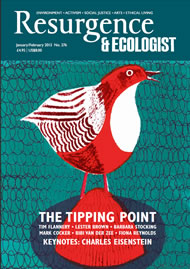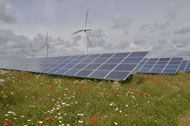“Look, a blue butterfly!” says Andy Atkins excitedly. Juliet Davenport beside him peers at it: “I think it’s a Little Blue.” Atkins shakes his head: “No, it’s called a… Hang on, I’ll remember in a second.” The butterfly – a Small Blue (I look it up later) – makes its escape over the solar panel to our left, and we carry on walking, Atkins still trying to remember the species.
It’s not often you go butterfly spotting in a power plant. But that is where we are: the Westmill community wind and solar plant. Five large turbines and a stretch of 20,000 solar photovoltaic panels, owned entirely by the local community. Atkins, head of Friends of the Earth UK, is meeting Davenport, head of renewable energy supplier Good Energy, so that they can both see up close what they believe and hope will be one of the answers to the gigantic challenges facing British energy supply. And so far they are both looking pretty pleased with it.
So what exactly are these challenges? Any government minister will cite the urgent need for new energy infrastructure, the need to keep energy bills low, and the need to achieve some kind of energy security – i.e. to produce as much as possible of our own energy instead of being dependent on not-always-reliable foreign exporters. Energy minister John Hayes is less emphatic about the need to decarbonise our energy supplies (decisions made “above my paygrade” and “before I got here” he says, flatteningly). But this need is, for many (including the government’s own advisory body on climate change), the most vital priority of all.
And these imperatives hang over the future of a system that is creaking at the seams. “We’ve got a system that was built for 1950s’ demands,” says energy consultant Syed Ahmed. “We urgently need to construct a system which is fit for the 21st century.”
As Hayes frankly admits, the government has been fatally indecisive about this, to the extent that the Office of Gas and Electricity Markets (Ofgem) recently issued a warning about our rapidly narrowing safety margins on electricity provision. And electricity is just one part of the problem; energy also needs to be provided for our heating and transport systems. But the biggest problem of all, the issue that seriously hampers any decision or progress, is that what should surely be a simple technological decision has become enormously politicised.
Fuel may once have been a simple log of wood, and then a lump of coal. But these days every variety of fuel with the potential to produce energy for us – oil, coal, gas, nuclear, wind, water, sun, and an assortment of others – comes freighted with its own lobby and anxieties.
Coal is cheap and available domestically, but has an enormous carbon footprint. Gas is (for now) cheap and has a lower footprint, but leaves us dependent on imports and the ever-present threat of rising prices. Shale gas might be domestically available but is already attracting high levels of protest. And oil is perhaps the most politicised of all.
At the lighter end of the carbon spectrum, nuclear is expensive, both to construct and to keep going; the bill for processing and storing nuclear waste makes up more than half the Department of Energy and Climate Change budget every year. Then there are renewables – wind, both onshore and off, solar and biomass. These are all hugely promising sources and extremely carbon-light. But they are still expensive, there are far from enough of them in place, they require back-up, and onshore wind in particular has become a political row all by itself.
Somehow, ministers must pick through all this and construct the future of our energy supply. Unfortunately, the politicisation of the different fuels seems to have extended into Westminster, with horns being locked over nuclear, gas and wind. The coalition government means we have Liberal Democrat Ed Davey as Secretary of State for Energy and Climate Change, trailing all the green convictions of his party (its 2010 manifesto promised 40% of electricity from low-carbon sources by 2020, and a clear renewables pathway to 2050). But he must answer to the Conservative George Osborne in the Treasury, who clearly shares some of the sceptical instincts of his party’s right wing.
Which leaves us facing a spectrum of possible outcomes, according to policy advisers and experts. In the worst scenario, Atkins worries, the civil servants go for “a small number of big bits of kit – a few nuclear power stations, coal, gas – which is a lot simpler than actually having to get your head round a multiplicity of ways of doing it and a new type of grid”. They build unabated gas power stations (with no carbon capture and storage), which look cheap – but then are in deep trouble as gas prices rise as we compete for sources with India, China and countries such as Germany that are decommissioning their nuclear power stations. Nuclear power splits opinion, with some believing that it is just not financially viable, while others see it as a vital part of a decarbonised energy supply.
The greatest source of anxiety by far, however, is any sign of hesitation by the government over renewables and energy demand. Offshore wind grew, points out Erin Gill of Windpower Offshore, at a staggering rate of 98% in the first half of 2012, “and there is no shortage of people wanting to come and invest in offshore wind in the UK”. Indeed, a report by the Confederation of British Industry in August 2012 showed that growth in our green industries had accounted for a third of all economic growth in the UK over the previous year.
And the future holds even more potential, which almost everyone believes – except, apparently, George Osborne. Rick Wheal of engineering consultancy Arup describes a world where a mixture of solar panels, heavy-duty insulation, double glazing and a number of other measures means that the energy use of our homes can be reduced by 80%. “We can build buildings that are incredibly low-energy. We can drop 80% from your average Victorian house. We can make it so energy efficient you don’t have to worry about heating – simply running up and down the stairs to look after your children will be enough to heat your house. These things are technologically possible now.”
Ahmed envisions district heating networks, with a central combined heat and power boiler supplying several hundred homes, “rather than the current system where you have an inefficient boiler in every home, and electricity travelling long distances down old networks and being colossally wasted in the process”.
Phil Jones of Northern Powergrid imagines going into whole towns and creating deals to use smart meters and other technologies to manage their energy demands across the day, reducing the need for baseload energy supplies. Atkins and Davenport want to see more community-owned wind and solar farms – like the one at Westmill – spreading around the country, so that there is an increasing sense of local energy ownership. “Community ownership is absolutely key,” they argue. “Decentralisation is where we’re going.”
And everyone talks about the smart grid. “There is technology now,” says Atkins, “that would enable your power company to turn your fridge down or switch your freezer off totally automatically when demand is outstripping supply. It wouldn’t do any damage whatsoever to what’s in your freezer. In fact it would actually save you money.”
This is not just a dark green fantasy. This vision is shared right across the political spectrum. Even David Cameron is a fan, using his party conference speech to highlight the fact that the UK is number one in the world for offshore wind and marine energy. A serious investment in green tech would generate not just power but jobs, and also solve energy security anxieties. It would be expensive, but it would be domestic investment, the kind of investment, argue many – including the CBI, not normally known for its eco-lunacy – that would grow British industry where currently there is none.
So why the hesitation? Davenport points out that renewable energy “is actually the democratisation of energy. Suddenly it means that we don’t have to rely on other people for energy, and this can and always will be threatening in some quarters, because people who are used to having power like to keep it.”
But as I stand here between the solar panels at Westmill, what is possible begins to seem very real. The machinery in this scruffy field has a combined maximum capacity of 12MW – enough for about 10,000 homes – and will soon be generating income for the community group that owns it. Atkins and Davenport can hardly tear themselves away. “All this extraordinary stuff is possible already,” says Atkins, being tugged by a colleague towards the car (their train is due to leave in 12 minutes precisely). He waves at the panels. “It’s more about the political will to get behind it.”








